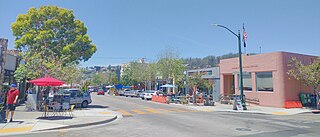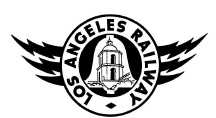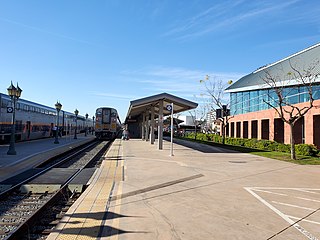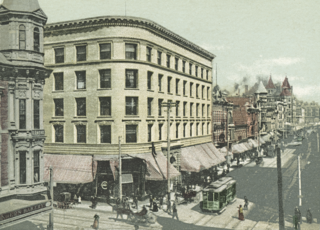Related Research Articles

The Pacific Electric Railway Company, nicknamed the Red Cars, was a privately owned mass transit system in Southern California consisting of electrically powered streetcars, interurban cars, and buses and was the largest electric railway system in the world in the 1920s. Organized around the city centers of Los Angeles and San Bernardino, it connected cities in Los Angeles County, Orange County, San Bernardino County and Riverside County.

The San Diego Electric Railway (SDERy) was a mass transit system in Southern California, United States, using 600 volt DC streetcars and buses.

Solano Avenue in Berkeley and Albany, California is a two-mile (3.2 km) long east-west street. Solano Avenue is one of the larger shopping districts in the Berkeley area. Businesses along Solano Avenue cover a wide range, including grocery stores, coffee shops, drugstores, bookstores, antique dealers, apparel outlets, ethnic restaurants and a movie theater.

The Los Angeles Railway was a system of streetcars that operated in Central Los Angeles and surrounding neighborhoods between 1895 and 1963. The system provided frequent local services which complemented the Pacific Electric "Red Car" system's largely commuter-based interurban routes. The company carried many more passengers than the Red Cars, which served a larger and sparser area of Los Angeles.

The East Bay Electric Lines were a unit of the Southern Pacific Railroad that operated electric interurban-type trains in the East Bay region of the San Francisco Bay Area. Beginning in 1862, the SP and its predecessors operated local steam-drawn ferry-train passenger service in the East Bay on an expanding system of lines, but in 1902 the Key System started a competing system of electric lines and ferries. The SP then drew up plans to expand and electrify its system of lines and this new service began in 1911. The trains served the cities of Berkeley, Albany, Emeryville, Oakland, Alameda, and San Leandro transporting commuters to and from the large Oakland Pier and SP Alameda Pier. A fleet of ferry boats ran between these piers and the docks of the Ferry Building on the San Francisco Embarcadero.

Bakersfield station is an intermodal facility in Bakersfield, California. It is the southern terminus of Amtrak California's San Joaquins route, with Amtrak Thruway buses continuing to Amtrak stations and bus stops throughout Southern California and Nevada. The station opened with a celebration on July 4, 2000. It contains an 8,300-square-foot (770 m2) train station with two platforms and three tracks, as well as a 17-bay bus station.

Transportation in Tulsa, Oklahoma includes a bus network and a system of raised highways and primary thoroughfares, laid out in mile-by-mile increments. In addition, throughout its entire length in Tulsa, historic Route 66 is a drivable road, with motels and restaurants reminiscent of the route's heyday era.
East Bakersfield is a region in Bakersfield, California directly east of downtown. The region was formerly known as the town of Sumner, which was later incorporated and renamed Kern City. It is primarily a mixture of residential and commercial developments. It also contains a small business district centered on the intersection of Baker and Sumner streets. Census data is provided on the right for the time period when the region was an independent town and city. It is part of the Bakersfield urban area of almost 500,000 people.

Kern County’s transportation system was quoted as the “unseen industry.” Located at the southern end of the San Joaquin Valley, the county is at a prime location to ship goods west to the central coast, south to ports in Los Angeles, and east to corridors that connect to the rest of the country. It is also on major corridors that link to all northern points.

7 was a streetcar line in Los Angeles, California. The service was operated by the Los Angeles Railway from 1932 to 1955. It ran from Spring and 2nd Streets to Athens and 116th Street, by way of Spring Street, Main Street, Broadway Place, Broadway, and Athens Way. During its Los Angeles Transit Lines days, around 1950 to 1955, Line 7 was rerouted off South Broadway to Central Avenue, at least as far north as 7th Street across Olympic Boulevard to possibly Vernon Avenue, covering trackage that was abandoned rail by line U, when that line was converted to trolley bus August 3, 1947.
9 was a streetcar line in Los Angeles, California. It was operated by the Los Angeles Railway from 1932 to 1955.

The Bakersfield Department of Development Services is a department of the city of Bakersfield, California. The department enforces the city's building codes and land use policies. It also issues building permits, and give approval for new land development. It also provides inspections of new and existing buildings.
The F Street and H Street Loop was a line of the Bakersfield and Kern Electric Railway. It originally operated as a loop on F Street and H Street, between 19th Street and California Avenue. The line was constructed in 1903, as part of the original expansion plan. The exact date the line was closed, and converted to buses is not known. However, the line was upgraded in 1909, and was not operating in 1922.
The South Chester Line was a line of the Bakersfield and Kern Electric Railway. The route originated at the intersection of 19th Street and Chester Avenue, and traveled south on Chester. At the southern end of the line, there was a loop around 8th Street, N Street, and 11th Street. The line was constructed in 1903, as part of the original expansion plan. It closed in 1939.
The North Chester Line was a line of the Bakersfield and Kern Electric Railway. The route originated at the intersection of 19th Street and Chester Avenue, and traveled north on Chester. For most of its life, the line was combined with the West 19th Street Line. The line was constructed in 1903, as part of the original expansion plan. It closed in 1933.
The West 19th Street Line was a line of the Bakersfield and Kern Electric Railway. The route originated at the intersection of 19th Street and F Street, and traveled west on 19th Street. It would turn south on Oak Street and terminate at Truxtun Avenue. For most of its life, the line was combined with the North Chester Line. The line was constructed in 1903, as part of the original expansion plan. It closed in 1933.
The Santa Fe and Southern Pacific Line was the main line of the Bakersfield and Kern Electric Railway. It operated between the Santa Fe Bakersfield Station and the Southern Pacific Bakersfield Station. It was the first line in the system, constructed in 1888. It was also the last line to close in the system, in 1942.

Bakersfield station is a former Southern Pacific Railroad station and hotel in Bakersfield, California. The station opened June 27, 1889, in the town of Sumner. The station was a mixture of Richardsonian Romanesque, Spanish Colonial Revival, and Moderne styles. It was closed in 1971, after the formation of Amtrak.
The OC Streetcar is a modern streetcar line currently under construction in Orange County, California, running through the cities of Santa Ana and Garden Grove. The electric-powered streetcar will be operated by the Orange County Transportation Authority (OCTA), and will serve ten stops in each direction along its 4.15-mile (6.68 km) route.
Streetcars in Redlands transported people across the city and region from 1889 until 1936. The city's network of street railways peaked around 1908 before the patchwork of separate companies was consolidated under the Pacific Electric.
References
- ↑ Bergman 2009, p. 124.
- 1 2 3 4 Lynch, George (March 11, 2008). "The Streetcars, Gone But Not Forgotten". The Bakersfield Californian. Archived from the original on July 7, 2011. Retrieved April 21, 2011.
- 1 2 Bergman 2009, pp. 124–125.
- ↑ Bergman 2009, p. 125.
- ↑ Bergman 2009, pp. 125–126.
- ↑ Bergman 2009, pp. 126–127.
- 1 2 Bergman 2009, p. 127.
- ↑ "Kern County Historic Chronology" (PDF). Kern County Museum. Archived from the original (PDF) on September 29, 2011. Retrieved April 21, 2011.
- ↑ Bergman 2009, pp. 134–136.
- 1 2 3 4 5 Bergman 2009, pp. 139–140.
- 1 2 Bergman 2009, pp. 140–142.
- Bergman, John (2009). The Southern San Joaquin Valley: A Railroad History. Visalia, California: Jostens Printing and Publishing Company. ISBN 978-0-615-25105-9.